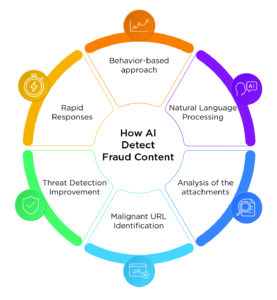A corporate company is always dealing with threats to its cybersecurity. Emails are one such threat which has always been a threat. Most corporates communicate through emails within the organization and for possible outreach to potential clients as well. The scam of phishing emails is very common for cybercriminals. Through that they can access the systems of the organizations, thus risking sensitive or confidential data.
To counter these email scams, organizations can employ AI email security solutions that can detect these malignant emails as AI can construct models for the security and can grow in knowledge enabling it to detect these attacks. Let's check out the impacts of AI on email security and the AI email security solutions.
Why Is AI Important in Email Security?
The capacity to evaluate vast quantities of data and patterns that a human may miss is key to the importance that it has in email security. It can spot and engage to respond to the dangers in real-time, considerably reducing the vulnerability of the cybersecurity of an organization.
The algorithm that makes an AI perpetually learns from the emerging landscapes and the new data, that allows them to adjust to the newer and continuously evolving cyber threats. By using AI, email security solutions can anticipate, determine and mitigate attacks like phishing, spyware, ransomware, which aids the strengthening of total cybersecurity. Integration of AI in email security is crucial for organizations to outsmart the cyber competitors and competently safeguard the confidential and sensitive database.
How does AI Detect Fraud Content?
Phishing emails and their content become refined over time. A multifaceted approach for the detection of malignant emails is paramount. For that, AI can help recognize phishing content in different ways.
Behavior-based Approach: AI can observe email traffic and observe and understand patterns of communication. Phishing emails frequently fluctuate from these patterns which allows AI to recognize the irregularity.
Natural Language Processing: AI can read and understand what is written in an email. Through that, AI can recognize the phishing content, that generally tries to trap you with a sense of urgency through a call of action button. Recently, I received an email, which had the sender's name as the CEO of the company saying “an urgent matter needs your attention” followed by an invitation to join a zoom meeting. When I checked for the giveaways, I saw the sender's email address. It was a random email address with no affiliation with the CEO of the company. I receive this kind of email frequently. An AI recognizes this pattern and flags it.
Analysis of the Attachments: Emails often come with attachments to make you believe that it is genuine. That’s the length to which the scammers go to fool you and beyond. Those attachments deliver malware to your system. Sandbox analysis of AI is used to detect if an attachment embodies malignant content before it is allowed to reach its intended destination.
Malignant URL Identification: Malicious sites that are linked to phishing emails can be detected by the AI. It can analyze whether the site in emails is likely to be a phishing site or a legit one.
Threat Detection Improvement: As AI offers various ways to detect new and refined phishing attacks, the phishing campaigns could have been successful had the AI email security solution wasn’t in place, would now be dealt with before they could do any damage.
Rapid Responses: As soon as the AI email security solution detects the threat, it is met with an appropriate response to prevent it from damaging the system.
How Artificial Intelligence Prevents Fraud in Email Security?
The fight against scam emails with the use of sophisticated AI algorithms to identify and prevent deceitful activities instantaneously is ongoing and revolutionary. The integration of email security solution which is AI-driven into your system necessitates careful and judgmental decision to establish a full, leakproof implementation and providing the utmost value to the clients.
To help integrate AI email security solutions, the MSPs (Managed Service Providers) can go with the following steps.
Evaluation of client requirements: The best way to start the integration of AI email security solutions is to document the organization’s present issues, challenges, and the objective of implementation.
Examining the best AI solutions: Before implementation, evaluate various AI email security solutions available while taking into consideration necessary attributes like precision of detection, seamless integration, adaptability and efficiency. Ensure the ease of incorporation of the solution with the existing MSP service. Deploy and configure solutions tailored to their ideal infrastructure requirements.
Modification and arrangements: AI email security solutions that are tailored to the clients' risk tolerance, security policies, and compliance.
Non-Interrupting detection and improvement: Continuously monitoring the performance of the AI email security solutions and improving them based on real-time feedback and continuing threat scenarios.
What Future Does AI Hold in Changing Cybersecurity?
With AI, something innovative is always around the corner. As AI becomes prevalent in email security, the demand for transparent and insightful algorithms for decision-making processes in explainable AI will rise. This would help the MSPs to understand and trust AI email security solutions. Automation by the AI will help MSPs to construct SOCs (autonomous security operations centers) which can identify, examine and respond to email threats without human help, changing the course of the AI email security solutions upwards.
Refinement of the AI’s threats detection is a continuous process, MSPs will benefit from the durable and resilient AI email security solutions. By incorporating solutions driven by AI and staying aware of the forthcoming trends in AI, MSPs can post themselves in a prime position for innovation.
For more information, visit us at SecureITWorld.
Explore More: Continuous Authentication: Securing Mobile Devices Ecosystem






